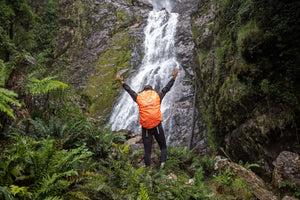Read and follow the pitching and packing instructions
Every BlackWolf tent comes with pitching and packing instructions and it'll help destress your camping holiday.
Always pitch your tent at home before taking it camping for the first time or if you haven’t used it for a while. This can help familiarise yourself with the process and as you can probably guess, it's a lot easier setting up your tent in the backyard on a fine day than arriving at your campsite when it's possibly dark or rainy.
If your tent has flexible poles that are connected with stretchy elastic, always assemble the sections one by one and make sure each pole end is fitted into the next one. When packing flexible poles start from the middle so the tension on the elastic is distributed evenly.
Don't store your tent wet
If there's time, allow your tent to dry thoroughly before packing it up at the end of your camping trip. There will often be some condensation on the inside of the fly and dampness from the ground underneath the floor (even if you had fine weather during your trip).
We also understand there are times when you have no choice but to pack up your tent while it's still wet. This is okay (don't stress!) but you should get the tent pitched and dry as soon as you can.
If a tent is stored wet, mould and mildew can quickly start to form and the waterproof PU coating can be damaged.
When you get home it is a good idea to get your tent out and air it to be completely sure it is dry before storing it in a dry, cool place.
Protect your tent from strong sunlight
Extended time in the sun will eventually damage all tent fabrics, if you are camping for a week or two in one place it is preferable for your tent to be in the shade for at least part of the day.
Keep your tent clean
While you are camping keep the floor inside your tent clear of sand, dirt and debris as much as possible. Quick tip: keep a small dust pan and broom around the campsite for sweeping out the floor area, and maybe have a no-shoes rule inside the tent.
Keep an eye out for bird droppings or tree sap on your tent fly and clean these off with water and a sponge as soon as you spot them.
If you camp in coastal areas, where your tent is exposed to salty sea breezes, you should pitch your tent when you get home and give it a good rinse off with the hose. Taking extra care to rinse and dry all metal components like pegs, pole ferrules and the knuckles and frame of Turbo Tents.
If your tent gets dirty or muddy, we recommend a fresh water rinse and wiping with a sponge (non-abrasive) or using a soft scrubbing brush. Just be careful not to scrub the PU coated side of the fabric (the inside). Avoid using soap or detergent if possible, for stubborn dirt or stains use a small amount of soap (not detergent) or a specially formulated outdoor gear cleaner (available at outdoor shops). Rinse thoroughly after washing, especially if you have used soap or other cleaners and of course, make sure your tent is completely dry before packing away for storage.
Is my tent still waterproof? Do I need to treat it?
Your tent has a DWR (Durable Water Repellant) treatment on the outside, which helps rain bead up and run off (like a freshly waxed car). After a while, DWR will become less effective and can be refreshed with a silicone spray (your tent will still be waterproof even after the DWR becomes less effective).
The main waterproofing of your tent fly fabric and most floors is a PU (polyurethane) coating on the inside of the fabric that forms a barrier stopping water from passing through so even if the fabric ‘wets out’ water cannot get through. This coating can break down if your tent is stored wet for an extended period of time so it is vital that your tent is completely dry when stored away.
After years of use, the PU coating may start to fail and so a reproofing spray can be used to re-waterproof the fabric and extend the life of your tent.
It is easy to confuse condensation on the inside of your tent with leaking, condensation occurs in still, humid conditions, you can read more about in our other article on condensation in tents.





